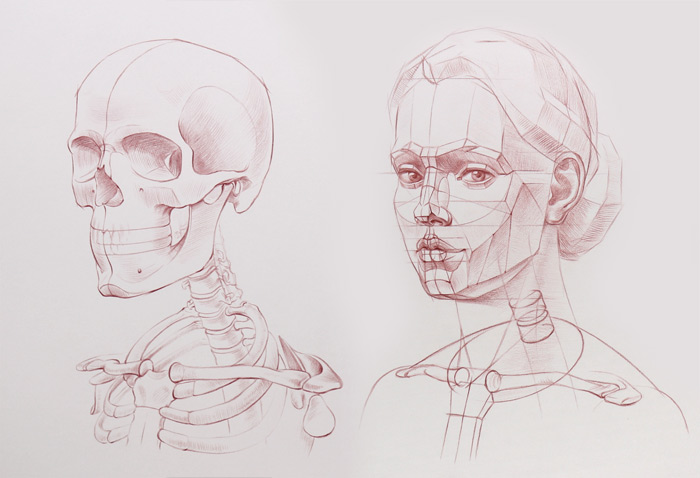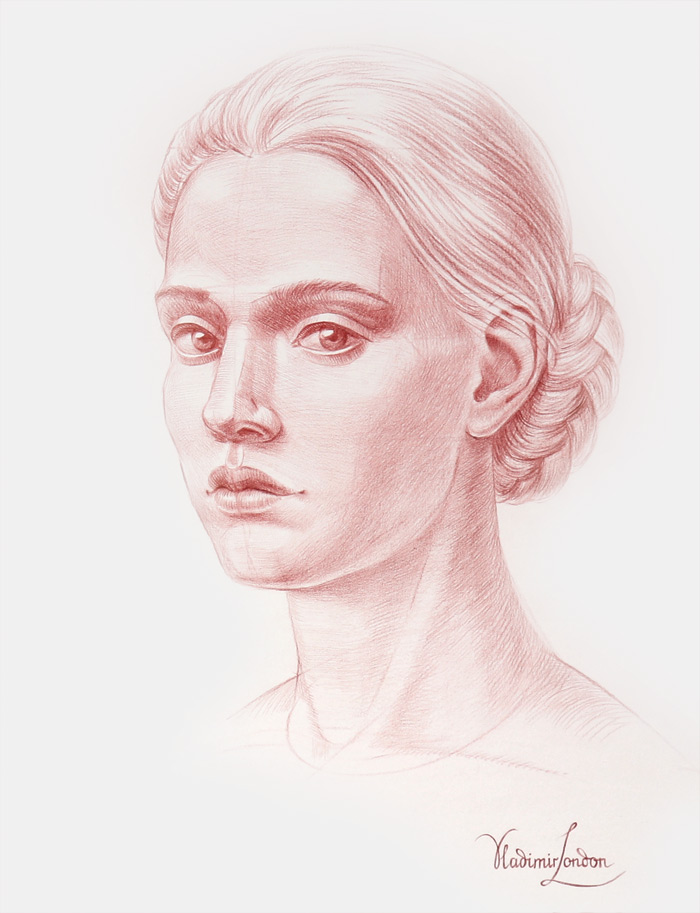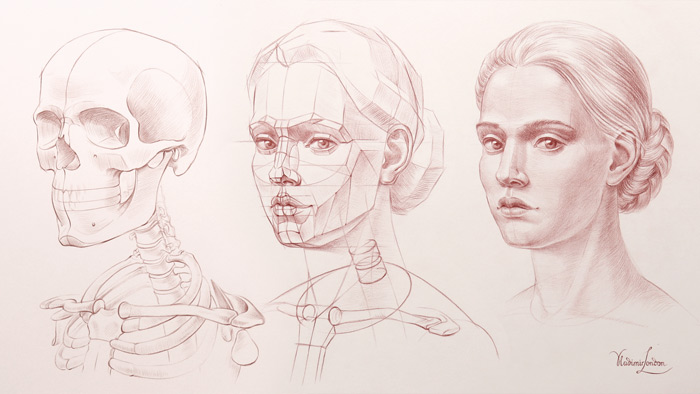Question from Richard:
“After drawing a rough portrait sketch, I can feel that there’s something off with respect to where facial features and other key points are placed. I can’t pinpoint what is wrong and could not correct those mistakes. Can you advise what do I need to know about portrait drawing and to pay attention to?”
Dear Richard,
Many thanks for your message.
It is clear from your question that when it comes to portraits, you have some gaps in knowledge of constructive drawing. Here are few points you may consider:
1. Measure with precision the overall proportion of the head and mark it in drawing as the first step. If this proportion is missing, do not expect other key points to be in place when this place is not even defined.
2. Stay inside the overall proportion mentioned above. If something doesn’t fit, either your main proportion is not correct, or the features are wrong.
3. Learn main proportions of a human head. Without this knowledge you won’t be able to draw good portraits. Here’s the test – can you tell ten main proportions of a human head? If not, how would you draw them?
4. Do you know what main alignments you need to check in your portrait drawing? Alignments are no less important than proportions.
5. Do you know the sequence of portrait drawing? Building a portrait the wrong way often leads to mistakes.
6. Can you tell which bones influence the shape of a head? What are their characteristic forms and alignments? Drawing a portrait is similar to drawing a skull, which is covered with skin and flesh only few millimetres deep. Can you draw a perfect skull from memory?

7. Do you render tonal values even if you feel that is something off? Do not expect that tonal rendering would fix constructive mistakes.

You are saying that you “can feel that there’s something off” in your portrait sketches. This is very good, it means you have an eye for detail and room for improvement.
You “can’t pinpoint what is wrong” because you draw from observation, not from knowledge, which is missing.
Drawing from observation (or drawing what you see) will not get you far. You have practiced the “skill of observation” your whole life by looking at people on a daily basis. How much did it help you in drawing portraits?
A proficient artist draws what one knows. Let me explain.
Let’s say two artists draw portraits of the same model. Despite they see the same model, what they know is very different.
To achieve likeness, a beginner will try to portray model’s features very accurately – draw eyes, eyelashes, lips, nose, ears, cheeks, chin and so on. Such an artist would also spend a considerable amount of time decorating all those details with tonal values. Yet, the end result is amateur and naive. The portrait has some resemblance to the model, but it is not a likeness; it is full of constructive mistakes and is finished with incorrect rendering.
A proficient artist would not bother with small features like eyes in the beginning. He knows that there are more important things to deal with: the overall proportions of a head, the main proportions of the face, the numerous alignments of bones and features. He “builds” a portrait step by step, proportion by proportion, alignment by alignment. When the construction is solid, checked and rechecked, he can decorate it with eyes, nose, mouth, etc., “constructively building” those features by drawing anatomy and proportions instead of copying what is seen on the surface. Such a construction is reinforced with tones that help reveal the three-dimensional nature of the head.
An advanced artist might not put all those construction lines on paper, but will keep them in mind and apply on autopilot, almost subconsciously. To some spectator it might look like easy and effortless drawing.
A good artist will focus on different tasks when drawing a portrait – making it a lookalike is not enough. He or she might work on depicting the inner world of the sitter, portraying emotions and personality of the model. Needless to say, this level requires a good understanding of portrait drawing rules, proportions and anatomy.
I hope this answers your question as to why you are facing challenges in portrait drawing and what you must learn to become a better portrait artist.
All the necessary portrait drawing steps, proportions and anatomy you will find in the Drawing Academy course and the Anatomy Master Class video lessons.
Also, the knowledge is not enough, you need to put it in practice.
This short video might give you some inspiration – these portrait sketches I have done from imagination in last few days just for practice. Fast sketches don’t have to be perfect; it is about quantity, not quality.
To your creative success,
Vladimir London
Drawing Academy tutor






This video was super informative.
Thank you,
Zora
thank you for sharing this incredible answer, I’ve noticed that some of my students tend to fall into the mistakes that you described and I will not underestimate this behaviour because fixing it with such clarity as you did in this answer will help them a lot.
thank you Vladimir
all the best
Michele
Excellent video. But, I just want to know, at this time, what is that pen Vladimir used for the demonstration he did of the head. I want one of those.
Chuck
Hi Chuck,
Thank you for your question. This is just an ordinary fountain pen, nothing special. Any dip pen or nib pen would do as well. You may want to use some brown ink though. The ink I’m using is a mix of sepia and red-brown. Trust me, it is not about tools, but skills ; )
Best regards,
Vladimir London
i love constructive drawing! i want study here !
Thank you so much, gives me hope to keep learning
I really liked watching this video. I took a Sum mi class once and the drawing re-
minds me of knowing where to put the lines and marks.
Thank you for that video and tips. I see the faults/mistakes i am making and must go back to drawing the skeleton and understand the parts of the head. I was working on a drawing of Mother Teresa and have been struggling with proportions. I’ve started over several times and each time felt it was off. I am working on a grid version but feel it also need improving.